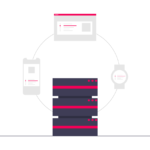When it comes to online marketing, it is often observed that most of those observations revolve around the Three Giants – Google, Amazon, and Facebook. In fact, as per market research, around 64% of all the expenditures on digital ads go to Facebook, Google and Amazon. For context, in 2020 alone, the digital ad expenditure in the US was $165B. Hence, they are automatically always in focus.
Now, considering how large and competitive the industry is, the fact that almost two-thirds of it has been captured by these companies might seem somewhat unreal. But once you get to know the underlying reason, things might start making sense. So, essentially, it is all about user data and the way these platforms structure their marketing techniques and most of all, this is due to the “walled garden” approach. To elaborate more on this, we will discuss the following points in this article.
- What Do We Mean by Walled Gardens?
- How Do Walled Gardens Affect the Marketing World?
- 5 Things About Walled Gardens Publishers Should Know
- Conclusion
What Do We Mean by Walled Gardens?
A walled garden may be looked at as a medium for creating a monopoly. It is a closed platform or a kind of ecosystem where the provider of the platform can have the entire control over applications, content, and/or media and also can put restrictions on access as it deems fit.
In the present times, the term has found more relevance in the context of ad tech. However, when it was first coined by Joe Malone, the founder of Telecommunications Inc, it had a different meaning. In the 1970s, when Google, Amazon, and Facebook were non-existent, a very good example of a walled garden was Bell System, the telecom provider. This company owned all of the hardware and also had some control over the data that passed through the lines of the telephone.
However, in the world of advertising, the meaning of the term is not exactly the same. But anyhow, it all comes down to the point where publishers are forced to use these walled gardens, i.e. closed kinds of ecosystems, for the purpose of running their campaigns.
How Do Walled Gardens Affect the Marketing World?
To be very honest, the phrase “walled garden” has carried a negative connotation for quite some time now in the ad tech industry. All it does is advocate exclusivity, leaving no scope for interoperability, and finally, the spectre of Big Tech looming large over the ad industry.
Due to the very restrictive nature of these walled gardens, it becomes very difficult for the advertisers to target specific audiences and in turn, measuring the effectiveness of their ad campaigns also becomes difficult. As a result, the growth of the ad-tech industry is also affected, and its growth is stunted to a huge extent. On top of that, it also creates an environment that is far less competitive, leading to higher ad prices and much fewer scopes of innovation.
However, nowadays, more and more publishers are considering building their own walled garden where their highly valuable first-party data can be put to use.
5 Things About Walled Gardens Publishers Should Know
If, as a publisher, your primary goal is generating ad revenue, then making use of a standard ad server and plugging into the ad exchanges might seem like an easy choice. But this method is very limited and demands compromises like obtrusive banner ads, slow loading times, low CPM, etc.
So building your very own walled garden will solve some of these issues, and here’s how:
Controlling the Revenue
Big data should not be allowed to control revenue. When the network is closed, you can control the ad platform and keep it restricted, decide on the rates of your ads and at the same time, focus on the scale. It is never a good idea to entrust your revenue stream to a third party, especially if it is the Google ad manager. The main reason for this is that it prioritizes its own revenue over that of the publishers.
Monetization of data in a privacy-centric scheme
You should understand that your first-party data is extremely valuable and unique. So it is advisable to let the advertisers utilize it to target a specific category of audiences without having to share the data itself. And now that third-party cookies are about to be dead, the first-party data becomes all the more valuable.
Removal of Third-Party Codes
Bulky SDKs, JavaScript Ad tags, and others might lead to slower apps, malware, and hidden cookies. The worst part is that these can cost you millions. But once you consider creating a walled garden, you can free yourself from third-party cookies.
Bypassing Ad-Blocking
If you are using a standard ad server, it will also mean that your ads will fall prey to ad blockers and even direct-sold ones. But once you build your own system, you will be able to bypass these and can open up to 20% more revenue.
Customizing your Ads
If you are building your own ad platform, it also means that you get to decide what your ads look like. The walled garden will let you take all your decisions by yourself. Instead of heavily depending on obtrusive ads, you will be able to serve ads that will easily blend in with your content and will not look out of place.
So, in essence, if you build a walled garden, it will mean that your ad revenue will not be contingent on the decisions that big ad techs make. For example, with the death of third-party cookies, publishers who serve programmatic ads might see their eCPMs drop, and this will lead to a substantial decline in the monthly ad revenue.
What Next for Publishers?
To be honest, to be in competition with walled gardens like Google, Amazon, Facebook, and Apple (GAFA) might seem impossible. However, these ecosystems can actually have a vital role to play in the lives of publishers, markets, advertisers, as well as the world in general.
Publishers should try to build their own walled gardens, but when it comes to the world of advertising, the least resistance-containing path is the one where the people already exist, and there are billions and billions of people in the world of GAFA.
FAQ Related to 5 Things About Walled Gardens
The term Walled Gardens was first coined by Joe Malone in the 1970s.
To use simple words, a walled garden may be defined as a closed kind of ecosystem, which is run by people who are within this ecosystem and without the active involvement of any external organization.
Google, Amazon, Facebook, and Apple are the biggest examples of Walled Gardens.

Shubham is a digital marketer with rich experience working in the advertisement technology industry. He has vast experience in the programmatic industry, driving business strategy and scaling functions including but not limited to growth and marketing, Operations, process optimization, and Sales.



![Top 12 Ad Networks in India Every Publisher Should Know [2024 Edition] Indian Ad Networks](https://www.adpushup.com/blog/wp-content/uploads/2019/09/undraw_Note_list_re_r4u9-270x180.png)



